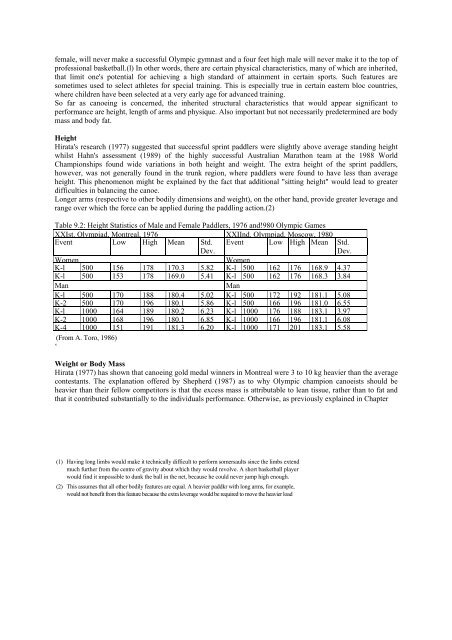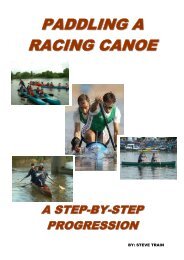The Science of Canoeing By Richard Cox
The Science of Canoeing By Richard Cox
The Science of Canoeing By Richard Cox
Create successful ePaper yourself
Turn your PDF publications into a flip-book with our unique Google optimized e-Paper software.
female, will never make a successful Olympic gymnast and a four feet high male will never make it to the top <strong>of</strong><br />
pr<strong>of</strong>essional basketball.(l) In other words, there are certain physical characteristics, many <strong>of</strong> which are inherited,<br />
that limit one's potential for achieving a high standard <strong>of</strong> attainment in certain sports. Such features are<br />
sometimes used to select athletes for special training. This is especially true in certain eastern bloc countries,<br />
where children have been selected at a very early age for advanced training.<br />
So far as canoeing is concerned, the inherited structural characteristics that would appear significant to<br />
performance are height, length <strong>of</strong> arms and physique. Also important but not necessarily predetermined are body<br />
mass and body fat.<br />
Height<br />
Hirata's research (1977) suggested that successful sprint paddlers were slightly above average standing height<br />
whilst Hahn's assessment (1989) <strong>of</strong> the highly successful Australian Marathon team at the 1988 World<br />
Championships found wide variations in both height and weight. <strong>The</strong> extra height <strong>of</strong> the sprint paddlers,<br />
however, was not generally found in the trunk region, where paddlers were found to have less than average<br />
height. This phenomenon might be explained by the fact that additional "sitting height" would lead to greater<br />
difficulties in balancing the canoe.<br />
Longer arms (respective to other bodily dimensions and weight), on the other hand, provide greater leverage and<br />
range over which the force can be applied during the paddling action.(2)<br />
Table 9.2: Height Statistics <strong>of</strong> Male and Female Paddlers, 1976 and!980 Olympic Games<br />
XXIst. Olympiad, Montreal, 1976 XXIInd. Olympiad, Moscow, 1980<br />
Event Low High Mean Std. Event Low High Mean Std.<br />
Dev.<br />
Dev.<br />
Women Women<br />
K-l 500 156 178 170.3 5.82 K-l 500 162 176 168.9 4.37<br />
K-l 500 153 178 169.0 5.41 K-l 500 162 176 168.3 3.84<br />
Man Man<br />
K-l 500 170 188 180.4 5.02 K-l 500 172 192 181.1 5.08<br />
K-2 500 170 196 180.1 5.86 K-l 500 166 196 181.0 6.55<br />
K-l 1000 164 189 180.2 6.23 K-l 1000 176 188 183.1 3.97<br />
K-2 1000 168 196 180.1 6.85 K-l 1000 166 196 181.1 6.08<br />
K-4 1000 151 191 181.3 6.20 K-l 1000 171 201 183.1 5.58<br />
(From A. Toro, 1986)<br />
‘<br />
Weight or Body Mass<br />
Hirata (1977) has shown that canoeing gold medal winners in Montreal were 3 to 10 kg heavier than the average<br />
contestants. <strong>The</strong> explanation <strong>of</strong>fered by Shepherd (1987) as to why Olympic champion canoeists should be<br />
heavier than their fellow competitors is that the excess mass is attributable to lean tissue, rather than to fat and<br />
that it contributed substantially to the individuals performance. Otherwise, as previously explained in Chapter<br />
(1) Having long limbs would make it technically difficult to perform somersaults since the limbs extend<br />
much further from the centre <strong>of</strong> gravity about which they would revolve. A short basketball player<br />
would find it impossible to dunk the ball in the net, because he could never jump high enough.<br />
(2) This assumes that all other bodily features are equal. A heavier paddkr with long arms, for example,<br />
would not benefit from this feature because the extra leverage would be required to move the heavier load



